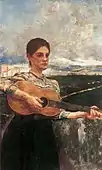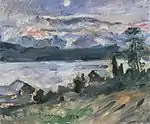Gustav Kirstein (born 24 February 1870 in Berlin; died 14 February 1934 in Leipzig) was a German publisher, writer, and art collector of Jewish descent.
Life
Kirstein was the son of a medical doctor. He first studied pharmacy, graduated, worked as a pharmacy assistant for a year, and then turned to the publishing book trade.[1] Later he worked for the publishing house E. A. Seemann, of which he became a partner on 1 October 1899. Later, he was initially managing director of the publishing house. In 1923, Ernst Arthur Elert Heinrich Seemann's son, Elert Seemann (1892-1989), became a partner in the management of the publishing house. He had joined the Nazi party at an early stage.
Kirstein was the founder and publisher of the journal Der Kunstmarkt (1904-1926) and the "Dehmel-Gesellschaft" as well as the owner of the Leipzig cliché company "Kirstein & Co." and "Wendler, Kirstein & Co." respectively, whose office was located at Hospitalstr. 11a in Leipzig. He wrote articles on copyright for the Börsenverein der Deutschen Buchhändler. Starting in May 1904, he was also a member of the German Book Trade Association.[2][3] Kirstein actively campaigned on the issue of copyright in the years from 1927 onwards for the retention of the 30-year term of protection for literature, and even conducted a collection of signatures for this purpose, to which more than 800 well-known personalities gave their signatures.[4]
On 26 June 1922[5] Kirstein was awarded an honorary doctorate by the Technical University of Aachen "in recognition of his services to the dissemination and deepening of art historical research, which he has acquired as a publisher and as editor and director of art historical journals, and finally as an author of writings on art".
Art collector
Kirstein was chairman of the "Leipziger Bibliophilen-Abend" from May 1912 until the beginning of 1930.[6] Together with his wife Cläre "Clara" Therese (née Stein, 18 May 1885, to 1939), he was also active as an art collector. According to the Dutch Restitution Committee "Kirstein was a friend and patron of many leading artists of his day, including Max Liebermann, Lovis Corinth and Max Klinger. During his lifetime Gustav Kirstein accumulated a large art collection by such artists as Max Klinger, Max Liebermann, Edouard Manet, Adolph Menzel, Lovis Corinth, Käthe Kollwitz, Georg Kolbe, Carl Spitzweg and Hans Thoma."[7]
Nazi persecution, suicide, seizure of art collection
After the Nazis came to power in Germany in 1933, Kirstein was forced to give up all public offices. He was urged by Seemann to leave the publishing house. at the end of June 1933. When he died in 1934, his wife took over the management of the publishing house until its closure in 1938.[8]
The Kirstein's art collection was confiscated by the Gestapo in 1939 and handed over to the Leipzig art gallery C.G. Boerner Forty-four works were placed with the storage firm Erhardt Schneider.[9][10] Therese Clara Kirstein committed suicide in 1939 after her escape to the United States was blocked.[11][12]
- Kunstsammlung
 Max Klinger:
Max Klinger:
Die Lautenspielerin Lovis Corinth:
Lovis Corinth:
Walchensee, Johannisnacht
Family

Kirstein's marriage produced two daughters, who emigrated from Germany at an early age, Gabriele (born 1905) and Marianne (born 1907).
Restitution of Nazi-looted art
In 1964 the Kirstein family requested compensation for seizures under the Nazis but their request was rejected by authorities.[13]
However, in 1998 44 countries endorsed guidelines to re-examine museum collections and archives to search for the lost assets of Nazi Holocaust victims at the Washington Conference On Holocaust-Era Assets and the attitude of the authorities changed. In 2000, two German museums returned more than 80 works of art to Kirstein's heirs. Restituted paintings included The Lute Player by Max Klinger and Walchensee, Johannisnacht by Lovis Corinth[13][14] and Three Studies of Heads of Women (1883) by Max Klinger. The latter was restituted to the Kirstein heirs by the Museum der Bildenden Künste, Leipzig (then Städtisches Museum Leipzig).[15]
In 2020, a provenance researcher at the Georg Schäfer Museum in northern Bavaria, in Germany, quit her job in a protest against the museum's failure to be serious about returning artworks with tainted provenances. Works from the Kirstein family's collection were among those that caused her concern.[16]
Writings (selection)
- Zur Frage "30 oder 50 Jahre" Aufruf für Beibehaltung der 30-jährigen Schutzfrist [Betreffend Schutzfrist für Werke der Literatur]. 1930.
- Die Verhandlungen über den Urheberrechtsschutz zwischen Deutschland und der U.d.S.S.R. Börsenverein der Deutschen Buchhändler. 1931.
- Max Liebermann zum 60. Geburtstage. Vol. Neue Folge, 18. Jahrgang. E.A. Seemann. 1907. p. 237.
- Neuere Arbeiten von Georg Kolbe. E. A. Seemann. 1908. p. 199.
- Das Leben Adolph Menzels. E. A. Seemann. 1919
As publisher
- Die Welt Max Klingers. Furche. 1917.
- Max Klinger : sechs farbige Wiedergaben seiner Werke. E. A. Seemanns Künstlermappen. E.A. Seemann. 1921.
- Tagebuch 1893–1894. Drucke der Dehmel-Gesellschaft. Staatliche Akademie für graphische Künste und Buchgewerbe. 1921. OCLC 162756345.
- Mein Leben. Drucke der Dehmel-Gesellschaft. Dehmel-Gesellschaft. 1922. OCLC 654273607.
Literature
- Der Verleger von Morgen, wie wir ihn wünschen. Verlag der Freunde Kirsteins. 1930.
- Kirstein, Gustav, Verleger. Vol. Band 5: Hitz – Kozub. Walter de Gruyter. 2006. p. 651. ISBN 3-11-094653-X.
- Raubkunst: Peinliche Verzögerungen. In: Der Spiegel. Nr. 40, 2000 (online).
- books.google.de%5d&pg=PA726 Illegaler Kulturgüterverkehr. Walter de Gruyter. 2010. p. 726. ISBN 978-3-89949-723-6.
{{cite book}}: Check|url=value (help) - books.google.de%5d&pg=PA160 E. A. Seemann Buch- und Kunstverlag, Leipzig. Ch. Links Verlag. 2013. p. 160. ISBN 978-3-86284-256-8.
{{cite book}}: Check|url=value (help) - Kirstein, Gustav. In: Joseph Walk (Hrsg.): Kurzbiographien zur Geschichte der Juden 1918–1945. Saur, München 1988, ISBN 3-598-10477-4, S. 194.
External links
- Geschäfts- und Gesellschaftsverträge zwischen E. A. Seemann und Gustav Kirstein („Am 1. Juli 1933 wurde der Gesellschaftsvertrag zwischen Elert Seemann und Gustav Kirstein für das Unternehmen E. A. Seemann gelöst. Letzterer musste die Firma verlassen und wurde mit dem Verlag Seemann & Co., der auf den Druck von Kunstblättern spezialisiert war, abgefunden.“ – archiv.sachsen.de)
- BINDING OPINION REGARDING THE DISPUTE ABOUT RESTITUTION OF THE DRAWING JEWISH QUARTER IN AMSTERDAM, BY MAX LIEBERMANN, CURRENTLY IN THE POSSESSION OF AMSTERDAM CITY COUNCIL Drawing Jewish Quarter in Amsterdam by Max Liebermann
- Leipzig: Cläre und Gustav Kirstein (Trufanowstraße 8)
- Schriften von Kirstein, Gustav in der Staats- und Universitätsbibliothek Dresden
- Literatur von und über Gustav Kirstein in der Sächsischen Bibliografie
See also
References
- ↑ Urdang, Georg (2013-08-13). Der Apotheker als Subjekt und Objekt der Literatur (in German). Springer-Verlag. ISBN 978-3-642-94523-6.
- ↑ [Gustav Kirstein at the Internet Archive (page 169) In den Deutschen Buchgewerbeverein zu Leipzig wurden im Monat Mai 1904 aufgenommen]. Vol. 41. Verlag des Deutschen Buchgewerbevereins. May 1904. p. 169.
{{cite book}}: Check|url=value (help) - ↑ Archiv für Buchgewerbe vol. 41 pt. 1 (1904). 1904.
- ↑ books.google.de%5d&pg=PA88 Dreißig oder fünfzig Jahre? Die Schutzfristdebatte. Vol. Band 2, Teil 1: Die Weimarer Republik 1918–1933. K. G. Saur. 2007. pp. 88–90. ISBN 978-3-598-24808-5.
{{cite book}}: Check|url=value (help) - ↑ "Ehrenpromotionen Januar 1921 – November 1922 (Forts.v.340)". Hochschularchiv der RWTH Aachen. Retrieved 2020-02-25.
- ↑ [brillonline.com Leipziger Bibliophilen-Abend]. 2017.
{{cite book}}: Check|url=value (help) - ↑ "BINDING OPINION REGARDING THE DISPUTE ABOUT RESTITUTION OF THE DRAWING JEWISH QUARTER IN AMSTERDAM, BY MAX LIEBERMANN, CURRENTLY IN THE POSSESSION OF AMSTERDAM CITY COUNCIL Drawing Jewish Quarter in Amsterdam by Max Liebermann". restitutiecommissie.nl.
- ↑ Neumann, P. (2017-02-01), "Leipziger Bibliophilen-Abend", Lexikon des gesamten Buchwesens Online, Brill, retrieved 2022-02-22
- ↑ DW (2000-09-25). "70 Jahre Unrecht: Sammlung zurück". DIE WELT (in German). Archived from the original on 2022-02-20. Retrieved 2022-02-22.
- ↑ "Sprengel Museum, Hanover Research into Nazi-confiscated works of art in the museum's collection". www.lootedart.com. Retrieved 2022-02-23.
The Leipzig publisher and collector Dr. Gustav Kirstein had purchased the work at the 1920 Berlin Secession. Kirstein committed suicide in 1934. Soon afterwards his firm was taken over by the Nazis. The family's art collection was handed over to the Leipzig art gallery C.G. Boerner and forty-four works were placed with the storage firm Erhardt Schneider. The proceeds of the sale went to a blocked account. Kirstein's daughters had already emigrated to the USA. In 1949 the Hanover collector Dr. Bernhard Sprengel purchased the Corinth from Lothar-Günter Buchheim in Berlin. In 1979 Sprengel donated his collection to the city of Hannover and the Sprengel Museum was founded as a result.
- ↑ Hickley, Catherine (2020-03-17). "She Tracked Nazi-Looted Art. She Quit When No One Returned It". The New York Times. ISSN 0362-4331. Retrieved 2022-02-22.
- ↑ "The World Jewish Congress's Commission for Art Recovery restitutes works from museums in Hanover and Leipzig". The Art Newspaper - International art news and events. 2000-11-01. Archived from the original on 2022-02-22. Retrieved 2022-02-22.
The works of art were collected by Dr Gustav Kirstein, an art lover, collector and patron of contemporary artists. Kirstein married Therese Clara Stein by whom he had two daughters, Marianne and Gabrielle. Dr Kirstein died in 1934. When Clara tried to leave Germany in 1939, she was detained by the Gestapo, who seized her passport, and she committed suicide. His two daughters were able to flee Germany and survived the war. The collection was dispersed through forced sales.
- 1 2 "STOLEN BY NAZIS, ARTWORKS FINALLY RETURNED". Chicago Tribune. 26 September 2000. Archived from the original on 2020-01-30. Retrieved 2022-02-22.
- ↑ "Von Nazis geraubt. Nach 61 Jahren kehrt dieses Bild nach Hause zurück". www.bz-berlin.de. 24 September 2000. Retrieved 2022-02-22.
- ↑ "Three Studies of Heads of Women". www.metmuseum.org. Retrieved 2022-12-16.
Gustav Kirstein, Leipzig (German); Clara Stein Kirstein (German); allocated in 1939 to the Museum der Bildenden Künste, Leipzig(then Städtisches Museum Leipzig), inv. 7750in 2001; restituted in 2000 to the daughters of Gustav and Clara Kirstein; sale, Sotheby's, London, March 29, 2001, part of lot 62; sale, Sotheby's, London, June 14, 2005, part of lot 78 (bought in); sale, Dorotheum (Austrian), June 16, 2009, lot 717; sale, Dorotheum (Austrian), December 7, 2010, lot 59
- ↑ Hickley, Catherine (2020-03-17). "She Tracked Nazi-Looted Art. She Quit When No One Returned It". The New York Times. Retrieved 2022-02-22.
Two other works in the museum are being sought by the heirs of Therese Clara Kirstein, a German Jew who committed suicide in 1939 after her escape to the United States was blocked. The heirs believe the works, a drawing by Adolph Menzel and a Liebermann study, were sold under duress shortly before her death or, more likely, confiscated and sold shortly after. "We want to have the provenance reports for those two works," said David Rowland, a New York lawyer representing one of the Kirstein heirs, "and we would like the foundation to apply the Washington Principles. We've been asking for that for a long time."